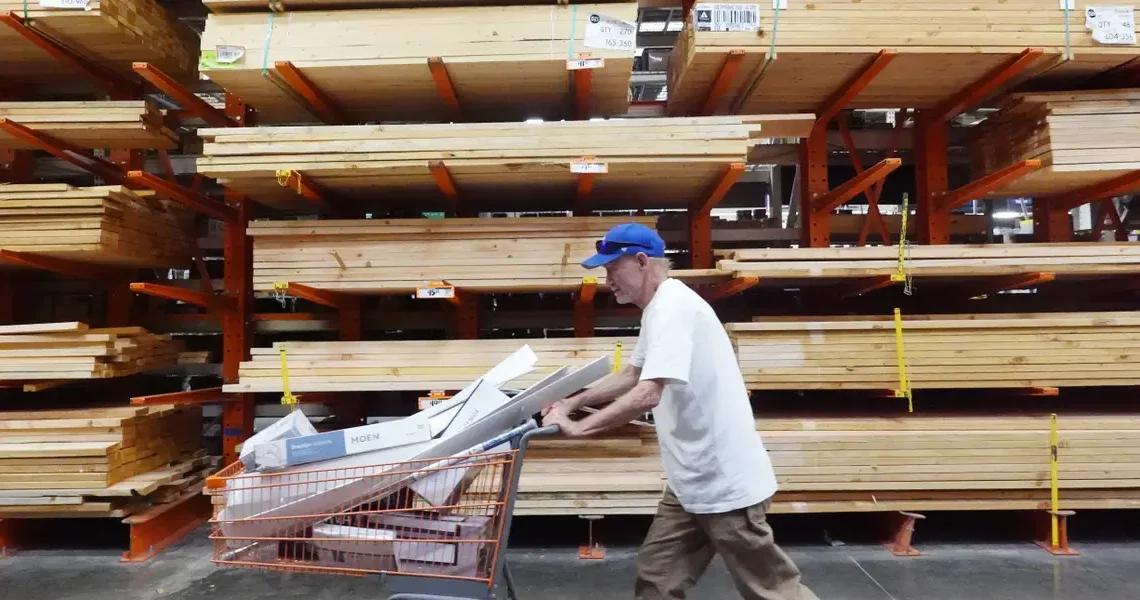Home Depot just became the latest major retailer to warn that the slowdown in consumer spending is spreading.
The home improvement cut its full-year outlook on Tuesday, reporting weakening sales growth for Q3.
Comparable sales — a key measure that strips out new store openings — rose by just 0.2% with US comps up by 0.1% — falling short of Wall Street’s expectations and underscoring a subtle yet important shift: more financially stable shoppers are starting to pull back.
“An expected increase in demand in the third quarter did not materialize. We believe that consumer uncertainty and continued pressure in housing are disproportionately impacting home improvement demand,” said Ted Decker, chair, president, and CEO of Home Depot.
Middle-class shoppers are pulling back
Evidence is mounting that it’s not just lower-income shoppers who are becoming more cautious with their spending.
Home Depot’s customer base tends to be relatively well off. And the chain benefits when people buy or renovate homes, but higher borrowing costs and a sluggish housing market have slowed that activity.
The company had expected better results as interest rates eased — but even that tailwind wasn’t enough.
Brian W. Nagel, senior equity research analyst at Oppenheimer & Co., told CNBC on Tuesday that the company is facing “a convergence of negative factors” as both housing activity and discretionary spending weaken.
“They’re not getting any help from the housing market,” which is stagnant right now, he said, adding that the consumer backdrop “is going from soft to softer — and that’s happening quickly.”
Milder weather and a lack of storms also affected sales, Home Depot said, curbing demand for seasonal products such as roofing materials and generators, which typically boost late-summer revenue.
In a note to clients on Tuesday, retail analyst Neil Saunders of GlobalData Retail said the calmer weather hurt demand across the sector, while uneasy consumers chose to spend on travel and leisure instead of home upgrades.
He estimated that home-improvement projects declined 0.8% from last year, with the steepest drop in big-ticket remodels that require financing.
A broader retail warning
It’s part of a growing pattern across retail.
Earlier this month, McDonald’s CEO Chris Kempczinski said that higher-income diners were trading down to cheaper meals, noting that “value matters to everybody, whether you’re upper income, middle income, or lower income.”
Meanwhile, pricier restaurant chains Cava, Chipotle, and Sweetgreen said in recent earnings calls that young customers were cutting back and eating at home to save cash.
Chad Lusk, managing director in consumer and retail at consultancy firm Alvarez & Marsal, told Business Insider that some higher-income shoppers are increasingly making trips to lower-priced retailers and trading down on food to spend on apparel and electronics.
They’re changing their entire ingrained routines, he said, adding: “There are signs of real distress on the way.”
The bigger picture
The economic backdrop is adding to the unease.
The University of Michigan’s consumer sentiment index declined 6% in November to 50.3, its lowest level since 2022, with broad-based decreases in confidence across income groups as the prolonged government shutdown weighed on the outlook.
Year-ahead inflation expectations ticked up to 4.7%, according to preliminary data released on November 15.
At the same time, job cuts are rising sharply: US employers announced 153,074 layoffs in October — the highest for that month in over two decades — pushing total cuts this year past one million, up 65% from 2024, according to outplacement firm Challenger, Gray & Christmas.
The firm cited cost-cutting, AI integration, and weaker consumer demand as key factors behind the surge.
That trend could have a disproportionate effect on white-collar professionals — and, by extension, the retailers that rely on them.
Klarna CEO Sebastian Siemiatkowski said on CNBC’s Squawk Box on Tuesday that the rise of AI-driven job losses could alter the traditional dynamic of recessions.
“We might be — in the midterm — looking at an inverse of what anyone underwriting credit has seen for decades,” he said.
“What we are seeing now due to AI may be the inverse, where it might be the high-income households due to the white-collar jobs being affected,” he added.
For a company long considered a bellwether for the health of the American homeowner, Home Depot’s miss is a worrying sign.
If even its solid, middle-class customers are cutting back, the broader consumer economy may be in for a chillier winter than expected.
Read the original article on Business Insider
The post Middle-class shoppers are pulling back, sending alarms through the retail industry: ‘There are signs of real distress on the way’ appeared first on Business Insider.




